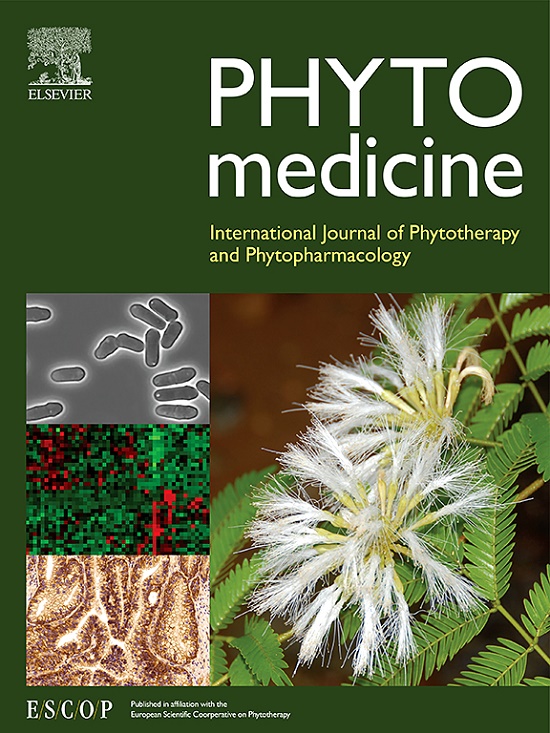Bioinformatics and molecular docking reveal Cryptotanshinone as the active anti-inflammation component of Qu-Shi-Xie-Zhuo decoction by inhibiting S100A8/A9-NLRP3-IL-1β signaling
IF 6.7
1区 医学
Q1 CHEMISTRY, MEDICINAL
引用次数: 0
Abstract
Background
Gout is a common type of arthritis marked by monosodium urate (MSU) crystal deposition in joints, triggering an inflammatory response. Qu-Shi-Xie-Zhuo (QSXZ), a traditional Chinese medicine (TCM) formula, has been clinically used for the treatment of gouty arthritis (GA).
Purpose
The study sought to examine the impact of QSXZ on GA and to delve into the pharmacological mechanisms that underlie its effects.
Methods
The chemical constituents of QSXZ were analyzed through UPLC-MS. MSU-induced acute gouty arthritis (AGA) and subcutaneous (SC) air pouch models in mice were employed to evaluate the anti-inflammatory properties of QSXZ and its primary active compound, Cryptotanshinone (CTS). To investigate the therapeutic mechanisms of QSXZ, we used MS-based network pharmacology, transcriptomic analysis, molecular docking and multiscale bioassays.
Results
Treatment of QSXZ revealed a significant reduction of inflammatory cell infiltration and the expression of pro-inflammatory cytokines tumor necrosis factor-α (TNF-α) and interleukin -1β (IL-1β). Based on UPLC/MS/MS results, 49 components were considered the active ingredients of QSXZ. Network pharmacology analysis indicated that QSXZ regulates multiple inflammation-related pathways. Subsequent transcriptomic analysis showed that QSXZ regulates gene expression of S100A8 and S100A9. Our investigation observed an increased expression of S100A8 and S100A9 in monocytes derived from gout patients. Molecular docking and molecular dynamics simulation analysis revealed the binding pattern and interaction between QSXZ active compound CTS and S100A8/A9, and subsequent surface plasmon resonance (SPR) and cell thermal shift assay (CETSA) experiments verified the direct interaction between them. To investigate the mechanisms of action, we conducted RT-PCR, Western blotting, immunohistochemistry, flow cytometry, and measured the inflammatory response. Our findings highlight the pathogenic role of S100A8/A9 mediated TLR4-NLRP3 axis in gout and review outstanding therapeutic effects of QSXZ and its primary active compound CTS on MSU-induced experimental models.
Conclusions
In summary, this study substantiates the therapeutic potential of QSXZ and its primary active compound CTS, as promising alternative treatments for GA. Our findings provide valuable insight into the critical pharmacological mechanism of QSXZ in regulating inflammation, highlighting its potential therapeutic effects in GA management.
生物信息学和分子对接揭示隐丹参酮通过抑制S100A8/A9-NLRP3-IL-1β信号通路,是祛湿解炎汤的有效抗炎成分。
背景:痛风是一种常见的关节炎类型,其特征是关节内尿酸钠(MSU)晶体沉积,引发炎症反应。祛湿泻炙(QSXZ)是一种中药方剂,已被临床用于治疗痛风性关节炎(GA)。目的:本研究旨在探讨QSXZ对GA的影响,并深入探讨其作用的药理学机制。方法:采用超高效液相色谱-质谱联用法对中药芪酸参的化学成分进行分析。采用msu诱导的小鼠急性痛风性关节炎(AGA)和皮下(SC)气袋模型,评价QSXZ及其主要活性物质隐丹参酮(CTS)的抗炎作用。为了探讨其治疗机制,我们采用了基于ms的网络药理学、转录组学分析、分子对接和多尺度生物测定等方法。结果:芪参散能显著降低炎性细胞浸润,降低促炎细胞因子肿瘤坏死因子-α (TNF-α)、白细胞介素-1β (IL-1β)的表达。通过UPLC/MS/MS分析,筛选出49种有效成分。网络药理学分析表明,QSXZ调节多种炎症相关通路。随后的转录组学分析表明,QSXZ调控S100A8和S100A9的基因表达。我们的研究发现,来自痛风患者的单核细胞中S100A8和S100A9的表达增加。分子对接和分子动力学模拟分析揭示了QSXZ活性化合物CTS与S100A8/A9之间的结合模式和相互作用,随后的表面等离子体共振(SPR)和细胞热移实验(CETSA)验证了它们之间的直接相互作用。为了研究其作用机制,我们采用了RT-PCR、Western blotting、免疫组织化学、流式细胞术,并测量了炎症反应。我们的研究结果强调了S100A8/A9介导的TLR4-NLRP3轴在痛风中的致病作用,并综述了QSXZ及其主要活性化合物CTS对msu诱导的实验模型的显著治疗作用。结论:综上所述,本研究证实了QSXZ及其主要活性化合物CTS作为GA的替代治疗方法的治疗潜力。我们的研究结果为QSXZ调节炎症的关键药理机制提供了有价值的见解,突出了其在GA治疗中的潜在治疗作用。
本文章由计算机程序翻译,如有差异,请以英文原文为准。
求助全文
约1分钟内获得全文
求助全文
来源期刊

Phytomedicine
医学-药学
CiteScore
10.30
自引率
5.10%
发文量
670
审稿时长
91 days
期刊介绍:
Phytomedicine is a therapy-oriented journal that publishes innovative studies on the efficacy, safety, quality, and mechanisms of action of specified plant extracts, phytopharmaceuticals, and their isolated constituents. This includes clinical, pharmacological, pharmacokinetic, and toxicological studies of herbal medicinal products, preparations, and purified compounds with defined and consistent quality, ensuring reproducible pharmacological activity. Founded in 1994, Phytomedicine aims to focus and stimulate research in this field and establish internationally accepted scientific standards for pharmacological studies, proof of clinical efficacy, and safety of phytomedicines.
 求助内容:
求助内容: 应助结果提醒方式:
应助结果提醒方式:


